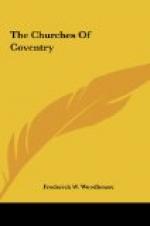The clearing away of galleries, the provision of new seating and the renewal of much window tracery have been the principal changes, the greatest loss being the destruction of the Corpus Christi Chapel. The nave is of moderate width and consists of only four bays, the eastern arches being narrower and made to abut against the tower after the manner of flying buttresses. The columns are clusters of four large filleted shafts separated by small ones while the bases are high and evidently meant to be seen above the benches. The caps are shallow and very simple, while the shafts of each pier reappear as part of the arch moulding.
The arcade as a whole is remarkably strong and dignified, it would perhaps have gained by the addition of a bay in length. In the absence of precise records it may be assigned to the second quarter of the fourteenth century or a little later. Above the tower arch can still be seen, beneath the painting and plaster, the marks of the older steep roof. The nave of Stratford-on-Avon Church has points of resemblance to this. There too we have a fourteenth-century arcade (but much simpler) with a fifteenth-century panelled wall and clearstory above, and the panelling comes down on to the backs of the arches in a similar though somewhat simpler manner.
Owing to the inequality of the eastern arches there is, in the position of the windows and roof principals a curious disregard of the lines of the piers and the centres of arches. There are eight equal bays in the roof and each corresponds to two two-light windows. It is interesting to compare the design of this clearstory with that of St. Michael’s. It has more solidity to accord with the more vigorous arcade though the treatment of the panelling is similar. The height from the arch to the roof is much less in proportion, but the sills of the windows are kept lower and the heads are square. The form of the windows is perhaps determined in part by the desire for more space for stained glass, but it is also the logical outcome of the space afforded by the level lines of a wooden roof just as the use of the pointed window follows from the use of pointed vaulting. The treatment of the angles after the manner of the thirteenth century “shouldered” lintel in order to take off the harshness of the rectangular form and to give a better bearing for the lintels is noteworthy and should be compared with the more developed forms at St. John’s Church.
Above the tower arch is a painting of the Last Judgement, discovered in 1831. It is now so much darkened that very little can be made out. The following is a description of its appearance before 1860: In the centre is the Saviour clothed in crimson and seated on a rainbow. Below are the Virgin Mary and St. John the Baptist with the twelve Apostles arranged on each hand. Two angels sound the summons to Judgement, and on the right of our Saviour, steps lead to a portico over which three angels look down




